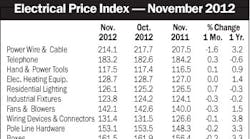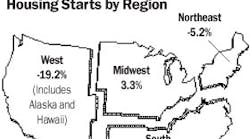Latest from Mag
People - Dec 21, 2012
Obituaries - Dec 21, 2012
November EPI Index Shows No Change
Housing Starts Dip 4% in November
Electrical Marketing - December 21, 2012
Around the Industry - Dec 21, 2012
Nonresidential building settled back after its improved performance during March and April, and nonbuilding construction (public works and electric utilities) retreated slightly. Residential building edged upward in May, helped by a brisk pace for multifamily housing, according to a report by McGraw-Hill Construction, New York.
During the first five months of 2005, total construction on an unadjusted basis was $241.8 billion, a gain of 2 percent relative to last year’s January-May period.
At a seasonally adjusted annual rate of $591.5 billion, new construction starts in May were down 1 percent compared to the previous month.
“Overall, the construction industry in 2005 continues to show a healthy volume of activity,” said Robert Murray, vice president of economic affairs for McGraw-Hill Construction. “Single-family housing remains very strong, and public works is being lifted by growth for its environmental categories.
“After a slow start to 2005, nonresidential building seemed to be regaining upward momentum. At the same time, May’s nonresidential decline suggests that renewed expansion for this sector may be hesitant, as developers continue to adjust to higher costs as a result of last year’s sharp runup in materials prices.”
Nonresidential building. In May, nonresidential building fell 5 percent to $147.8 billion (annual rate), after rising 15 percent during March and April from a very weak February. Store construction dropped 21 percent from a strong April, which saw groundbreaking for several large projects utilizing the “lifestyle center” format.
Office construction in May retreated 9 percent, essentially remaining stalled following the improved contracting witnessed last year. Hotel construction was down 4 percent in May, although some support did come from the start of an $80 million resort in Fort Lauderdale, Fla., and a $70 million hotel in Boston. Manufacturing plant construction continues to languish, sliding 13 percent in May. Running counter to the generally weaker May performance for commercial building was warehouse construction, which advanced 24 percent.
For the institutional categories, May declines were posted by schools, down 4 percent; health-care facilities, down 8 percent; and churches, down 15 percent.
Murray said, “While nonresidential building lost momentum in May, it’s still expected that coming months will see a return to the strengthening trend which appeared to take hold during March and April. For this to occur, those structure types that have been generally weak in the early months of 2005 — offices, hotels, warehouses, manufacturing plants — will need to reestablish the moderate growth witnessed last year.”
Nonbuilding construction. At $89.9 billion (annual rate), nonbuilding construction was down 2 percent in May. The nonbuilding decline was due partly to a 46 percent plunge for the volatile electric utility category, which resumed its broad weakening trend after a brief upturn in April. May also included a 24 percent drop for river/harbor development work as well as a 17 percent drop for highway construction, which retreated from a strong April that featured the start of several large highway projects.
Residential building. In May, residential building improved 1 percent to $353.8 billion (annual rate). Single-family housing posted a modest dollar volume decline of 2 percent, while still remaining at a very healthy volume (5 percent above its average level in 2004). Multifamily housing in May advanced 18 percent, pushed upward by the start of 40 projects valued at $25 million or greater. The five largest projects were located in Las Vegas ($142 million), Miami ($104 million, $87 million, $83 million), Orlando ($82 million), and Fort Lauderdale, Fla. ($77 million). The low cost of financing continues to support demand for both single-family housing and condominium development. During May, the 30-year fixed mortgage rate slipped to an average of 5.7 percent, down from 5.9 percent in April, and June has seen a further retreat to 5.6 percent.
Murray said, “It’s turning out to be another superlative year for single-family housing, even amidst concern over price “bubbles” in certain markets, and condominium development is also seeing robust activity.”
During May, the regional performance for residential building stayed within a narrow band — the South Atlantic, up 2 percent; the West, up 1 percent; the Northeast and Midwest, each unchanged from April; and the South Central, down 1 percent.
The 2 percent increase for total construction starts during the first five months of 2005, relative to 2004, was the result of 7 percent gains for both residential building and nonbuilding construction, combined with a 9 percent shortfall for nonresidential building.

